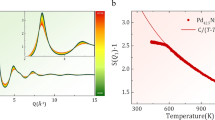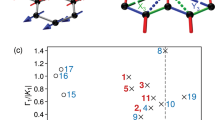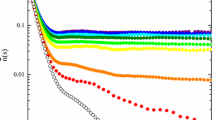Abstract
The striking behavior of the specific heat of liquid3He as function of temperature at low temperatures requires the effective massm* to change rapidly with temperature; this can be translated into a rapid variation with energy,m*/m dropping from itsE=0 value to ∼1 over the temperature range ≲0.5 K. We explore this effect in a model in which the enhancement of the effective mass is due to coupling to spin fluctuations. At very lowT≲50 mK, the variation in specific heat results fromT 3 lnT terms. The free energy, on the other hand, does not containT 2 lnT terms in its dependence on the magnetic field, implying that the susceptibility, which is essentiallym*/(1+F a0 ), also does not have such logarithmic terms. Consequently, ifm* varies with energy, so mustF a0 , so as to leave the susceptibility free of this rapid variation. The rough constancy ofm*/(1+F a0 ) seems empirically to hold to higher energies and temperatures. Ifm*/m drops, with increasing energy, to unity, the spin-fluctuation theory, which is described in terms of Landau parameters at the Fermi surface, goes over into the paramagnon theory. The rapid change with energy of the effective interactions can be understood within the framework of response theory as a “shaking off” of the relevant collective modes with increasing frequency of the imposed oscillations. The changes in effective interactions have consequences for the interpretation of experiments involving inelastic neutron scattering from liquid3He.
Similar content being viewed by others
References
P. W. Anderson,Physics 2, 1 (1965).
R. Balian and D. R. Fredkin,Phys. Rev. Lett. 15, 480 (1965).
S. Engelsberg and P. M. Platzman,Phys. Rev. 148, 103 (1966).
M. J. Buckingham and M. R. Schafroth,Proc. Phys. Soc. (London)A 67, 828 (1954).
G. M. Eliashberg,Zh. Eksp. Teor. Fiz. 43, 1105 (1962) [Sov. Phys.—JETP 16, 780 (1962)].
C. J. Pethick, inLectures in Theoretical Physics, Vol. XI-B, K. Mahanthappa and W. E. Britten, eds. (Gordon and Breach, New York, 1969).
S. Doniach and S. Engelsberg,Phys. Rev. Lett. 17, 750 (1966).
S. Doniach, S. Engelsberg, and M. J. Rice, inProc. Xth Int. Conf. on Low Temp. Phys., M. P. Malkov, L. P. Pitaevski, and Yu. D. Anufrieyev, eds. (Viniti, Moscow, 1967), Vol. I, p. 356.
N. F. Berk and J. R. Schrieffer,Phys. Rev. Lett. 17, 433 (1966).
Gordon Baym and C. J. Pethick, inThe Physics of Liquid and Solid Helium, Part II, K. H. Bennemann and J. B. Ketterson, eds. (Wiley, 1978) p. 1.
G. Grimvall, inSpecial Topics in Solid State Physics, Vol. XVI, E. P. Wohlfarth, ed. (North-Holland, 1981).
R. Balian and C. T. DeDominicis,Ann. Phys. (N.Y.)62, 229 (1971).
C. J. Pethick and G. M. Carneiro,Phys. Rev. A 7, 304 (1973).
G. M. Carneiro and C. J. Pethick,Phys. Rev. B 16, 1933 (1977).
J. C. Wheatley,Rev. Mod. Phys. 47, 415 (1975); A. C. Mota, R. P. Platzeck, R. Rapp, and J. C. Wheatley,Phys. Rev. 177, 266 (1969).
T. A. Alvesalo, T. Haavasoja, P. C. Main, M. T. Manninen, J. Ray, and L. M. M. Rehm,Phys. Rev. Lett. 43, 1509 (1979); T. A. Alvesalo, T. Haavasoja, M. T. Manninen, and A. T. Soinne,Phys. Rev. Lett. 44, 1076 (1980).
W. F. Brinkman and S. Engelsberg,Phys. Rev. 169, 417 (1968).
G. E. Brown and Mannque Rho,Nucl. Phys.,A372, 397 (1981).
C. Mahaux and H. Ngô,Phys. Lett. 100B, 285 (1981).
K. Sköld, C. A. Pelizzari, R. Kleb, and G. E. Ostrowski,Phys. Rev. Lett. 37, 842 (1976); K. Sköld and C. A. Pelizzari,J. Phys. C 11, L589 (1978).
C. H. Aldrich III and D. Pines,J. Low Temp. Phys. 32, 689 (1978).
K. Bedell and D. Pines,Phys. Rev. Lett. 45, 39 (1980).
S. Babu and G. E. Brown,Ann. Phys. (N.Y.)78, 1 (1973).
M. T. Béal-Monod,J. Low Temp. Phys. 37, 123 (1979).
D. F. Brewer, J. G. Daunt, and A. K. Streedhar,Phys. Rev. 115, 836 (1959).
T. F. Roberts, R. H. Sherman, S. G. Sydoriak, and F. G. Brickwedde, inProgress in Low Temperature Physics, Volume 4, C. J. Gorter, ed. (North-Holland, 1964), p. 480.
J. Wilks,The Properties of Liquid and Solid Helium (Clarendon Press, Oxford, 1967).
S. Fantoni, V. R. Pandharipande, and K. E. Schmidt,Phys. Rev. Lett. 48, 878 (1982).
G. E. Brown, V. Mishra, and C. J. Pethick, unpublished.
Author information
Authors and Affiliations
Additional information
Also State University of New York, Stony Brook, New York. Supported in part by U.S. D.O.E. Contract DE-AC02-76ER13001.
Also University of Illinois at Urbana—Champaign. Supported in part by U.S. NSF Grant DMR 81-21273.
Rights and permissions
About this article
Cite this article
Brown, G.E., Pethick, C.J. & Zaringhalam, A. Energy dependence of the effective mass in liquid3He. J Low Temp Phys 48, 349–372 (1982). https://doi.org/10.1007/BF00681578
Received:
Issue Date:
DOI: https://doi.org/10.1007/BF00681578




